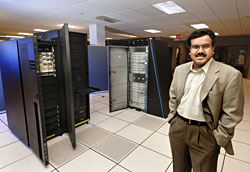A supercomputer for Iowa State University
01-30-06
Contacts:
Srinivas Aluru, Electrical and Computer Engineering, (515) 294-3539
Robert Jernigan, Laurence H. Baker Center for Bioinformatics and Biological Statistics, (515) 294-3833
Mike Krapfl, News Service, (515) 294-4917
A supercomputer for Iowa State University
AMES, Iowa -- Finally, Iowa State University researchers can talk about trillions of calculations per second.

Srinivas Aluru with the 73rd fastest supercomputer in the world. Behind him is the IBM Blue Gene/L model, containing 2,048 processors. At left is the data storage and equipment to make it operational. Photo by Bob Elbert. .
That's because a $1.25 million IBM Blue Gene/L supercomputer is now on campus. The National Science Foundation awarded a research team led by Srinivas Aluru, an Iowa State professor of electrical and computer engineering, $600,000 to purchase the supercomputer. Iowa State paid the remaining $650,000 with allocations from the President's Office, the Office of the Vice Provost for Research, Information Technology Services and the Plant Sciences Institute.
Other members of the supercomputing research team are Robert Jernigan, a professor of biochemistry and biophysics and director of Iowa State's Laurence H. Baker Center for Bioinformatics and Biological Statistics; Patrick Schnable, a professor of agronomy and director of the Center for Plant Genomics; and Arun Somani, a professor and chair of electrical and computer engineering.
"Iowa State University's first supercomputer will be a tremendous resource for our researchers involved in assembling the corn genome, studying protein networks and other very important areas of computational biology," said Iowa State President Gregory Geoffroy. "It will help us strengthen our programs in the biological and information sciences and support our faculty as they create, share and apply knowledge to benefit Iowa and the world."
Aluru accepted the supercomputer in full working condition on Friday, Jan. 20. It's running in Iowa State's Durham Center. Its black box with two blue stripes is about the size of a large refrigerator. It contains 2,048 processors. It includes 11 trillion bytes of data storage. It's the 73rd most powerful supercomputer on the current TOP500 list of the world's fastest supercomputers -- the first time Iowa State has ever made the list. It puts Iowa State among the top 10 university supercomputers in the United States. And the new supercomputer will be capable of a peak performance of 5.7 teraflops.
A teraflop equals 1 trillion calculations per second.
"Iowa State has never had a computer that even had one teraflop," Aluru said.
Aluru estimated Iowa State's supercomputer will be more than ten times more powerful than any high-performance computer currently on campus.
"High performance computing has been identified as a critical need by Iowa State's Plant Sciences Institute," said John Brighton, Iowa State's vice provost for research. "And researchers with Iowa State's Laurence H. Baker Center for Bioinformatics and Biological Statistics need more computing power to remain leaders in their field. This supercomputer gives those researchers and many others one of the tools they need to stay at the forefront of science and technology."
Bioinformatics involves using computers to collect and analyze large amounts of biological data.
Iowa State researchers will put the supercomputer right to work on some very large projects:
- Iowa State is one of four institutions working on a $29.5 million, three-year project to sequence the corn genome. The corn genome is considered the most complex sequencing project attempted to date. An estimated 65 percent to 80 percent of the corn genome contains repeats, making it very difficult to piece the genome together from the 30 million to 60 million small pieces to be sequenced. That's the challenge Aluru and Schnable aim to accomplish with the supercomputer.
- Iowa State researchers are also working to understand protein networks in whole organisms. Jernigan of the Baker Center said the networks can involve 30,000 proteins interacting with each other. Having a supercomputer on campus will be a big boost to that project.
"We can look at a lot more pieces at the same time," Jernigan said. "This is an important step for Iowa State. It's the unavailability of computers of this magnitude that limits many projects in engineering and computer science. This can have an important influence on all kinds of research."
Aluru -- a professor who scribbles illustrations on the office whiteboard when he explains the intricacies of large-scale expressed sequence tag clustering, the short DNA sequences that are used as landmarks in gene mapping -- said Iowa State's new supercomputer will allow researchers to expand the scale of their projects.
Yes, he said, "We'll look at the largest-scale problems at the forefront of science and engineering."
-30-